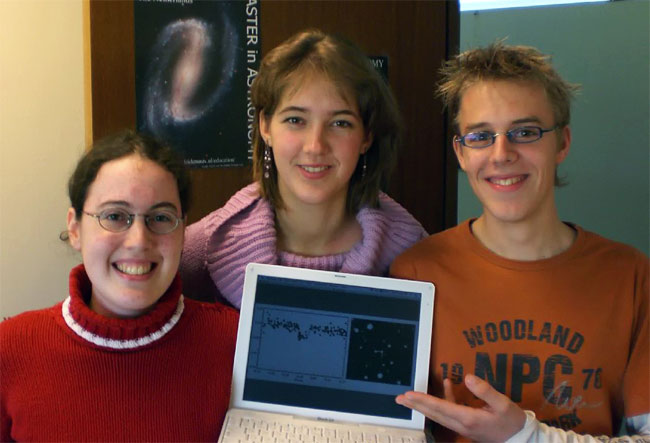Students Find Planet Outside Our Solar System

Threeundergraduate students have discovered a large planet orbiting a fast-rotatingstar. Extrasolar planet discoveries like this have become common, but this oneis unusual both for who found it and the type of star it orbits.
"It isexciting not just to find a planet, but to find one as unusual as this one; itturns out to be the first planet discovered around a fast-rotating star, andit's also the hottest star found with a planet," said one of the planet'sdiscoverers, Meta de Hoon of Leiden University in The Netherlands.
The otherLeiden-student team members included Remco van der Burg and Francis Vuijsje.
The planet,which is about five times as massive as Jupiter, circles its host star every2.5 days. It lies at only three percent of the Earth-sun distance from itsstar, making it very hot and much larger than many otherplanets.
The hoststar is about 12,000 degrees Fahrenheit (6,700 degrees Celsius). Forcomparison, the part of the sun we see reaches temperatures of 10,000 degrees F(5,500 degrees C). The planet is officially tagged as OGLE2-TR-L9b. "Butamongst ourselves we call it ReMeFra-1, after Remco, Meta, and myself," Vuijsjesaid.
Thestudents detected the exoplanet while testing a method for investigating lightfluctuations of thousands of stars in the OGLE database in an automated way.
The planethas not been seen directly. But the brightness of one of the stars decreasedfor two hours every 2.5 days by about one percent, suggesting a planet wastransiting in front of the star as seen from an earthly point of view. Follow-upobservations with ESO's Very Large Telescope in Chile confirmed that the dip inlight was caused by a planet passing in front of the star, blocking part of thestarlight at regular intervals.
Get the Space.com Newsletter
Breaking space news, the latest updates on rocket launches, skywatching events and more!
"Thisis the first planet found around a fast-rotating star, because it is verydifficult to confirm planets around these objects," the project supervisorIgnas Snellen of Leiden told SPACE.com.
He added,"So there must be many planets orbiting fast-spinningstars, but they are just difficult to find. This is because the fast spinmakes it difficult to measure the stellar 'wobble' needed to determine the massof the object orbiting it, and confirming it to be a planet."
Most of the300-plus exoplanets identified to date were detected by the so-called radialvelocity method, in which astronomers look for a star's wobble produced by thegravitational tug of an orbiting planet. But the transit method of detection isgaining steam. And recently, the firstactual photos of planets around other stars were made.
Thediscovery will be detailed in a forthcoming issue of the journal Astronomyand Astrophysics.
- Video ? A World Like Our Own
- Top 10 Most Intriguing Extrasolar Planets
- Video: Planet Hunter
Join our Space Forums to keep talking space on the latest missions, night sky and more! And if you have a news tip, correction or comment, let us know at: community@space.com.

Space.com is the premier source of space exploration, innovation and astronomy news, chronicling (and celebrating) humanity's ongoing expansion across the final frontier. Originally founded in 1999, Space.com is, and always has been, the passion of writers and editors who are space fans and also trained journalists. Our current news team consists of Editor-in-Chief Tariq Malik; Editor Hanneke Weitering, Senior Space Writer Mike Wall; Senior Writer Meghan Bartels; Senior Writer Chelsea Gohd, Senior Writer Tereza Pultarova and Staff Writer Alexander Cox, focusing on e-commerce. Senior Producer Steve Spaleta oversees our space videos, with Diana Whitcroft as our Social Media Editor.









